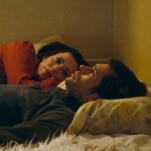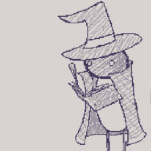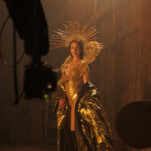Screening rats and bootleg-swappers always have a holy grail. It sits at the top of a list of titles, on a folded sheet of notebook paper or in a Word document, bolded, underlined, or marked with a little squiggly star. The list can start as a practical, to-do-type aid, but, after a few years, it becomes a formality, because the kind of person who maintains a list for that long already has the titles memorized. The list is a totem, and the satisfaction of crossing out an item or making a new list rubs some spot and soothes. These lists never get smaller; they only grow more obscure until they are filled with titles the list-maker has only a slim chance of ever seeing.
People who self-identify as snobs do not keep these kinds of lists, because people who self-identify as snobs are generally undiscerning and uncurious—they are, in short, the kind of people you don’t want to hang around if you’re interested in movies in a serious and possibly unhealthy way. Aching, list-making movie-madness tends to attract two types of people: connoisseurs and goofs. (Note: This is a non-standard taxonomy.) Connoisseurs are organized viewers who need to try everything one by one; they’re the kind of people who attend full retrospectives for directors they don’t like, just to figure out why they don’t like them. Goofs have unpredictable viewing habits; at festivals, they’ll skip the hyped stuff in favor of something that is totally unpromising, but which will probably never screen again.
The thing that unites connoisseurs, goofs, and high-volume viewers in general is that they are okay with being disappointed or bored. Normal folks—a category that caps off with, say, one trip to a movie theater per week—are understandably irked by dull, middling, and out-and-out bad movies, because they constitute a waste of a specific and limited amount of time and money. However, when your whole notion of calendar and budget is structured around seeing as many movies as possible, it’s hard to take the crappy ones personally. There’s a flip side to this, which is that, when your days are packed with screenings, the good and great movies tend to pop out or move you in a deeper way.
Advanced-level list-making involves a lot of disappointment and boredom, as well as a willingness to follow leads that will inevitably turn out to be dead ends, an ability to parse and mentally catalog large quantities of information, and, more often than not, a baseline knowledge of French, because French is to deep-digging movie culture what Latin was to the European medievals.
This is the point at which the distance between any given item and the future in which it can be crossed off the list has gotten very long, and that most-wanted thing, the holy grail, has shrunk into a pale dot on a very distant horizon. This is also the point at which list-making—or at least the kind of list-making that I know best, which is the movie kind—gets really absorbing and meaningful. The thing about these pale-dot holy grails is that, though searching for them is usually fruitless in the conventional sense, it can be edifying and educational, producing a whole lot of research and a whole lot more self-doubt. And, maybe even more importantly, it’s fun, in a 1,000-piece-jigsaw-puzzle sort of way.
Despite his Swiss accent, Swiss passport, and the fact that he has lived most of his life in Switzerland, JLG is closely identified with French cinema, even in France. He became fixated on movies during that first abortive stint in Paris, and when he returned, it was during the golden age of the ciné-clubs—the first list-makers, membership-based discussion groups that screened prints of older films. He would spend the next few years in and out of Paris, directing a handful of cutesy shorts, which seem auspicious only in retrospect. He also wrote film criticism, sometimes under his real name, sometimes as “Hans Lucas,” a German play on “Jean-Luc.” This name appears in the credits of Une Femme Coquette.
Tom Milne—the translator and editor of a book called Godard On Godard, which is going to figure pretty prominently in this text, because it’s figured pretty prominently in my life—is the only writer I know of to have seen Quadrille. Milne, who was British, had been a student at the Sorbonne during the golden age of the ciné-clubs, and he caught a screening, possibly the only one, at a 16 mm shorts program on the Rue Danton in 1950. According to his description, the movie was 40 minutes long, had no dialogue or discernible plot, and took place in the waiting room of a dentist’s office. Half of the audience walked out; the ones who stayed behind got into a screaming match arguing about whether it was any good or not.
A decade later, in 1960, JLG, nominal star of Quadrille, would premiere Breathless, his debut feature, a deconstructed crook-on-the-run flick that looked like no movie before it. Breathless received mixed reviews—the praise generally louder than the pans—and became an unlikely box-office hit. Over half a century later, it is still considered cool and more or less hip, in part because it is smart and jazzy and energetic in ways that no one has really been able to successfully replicate, though not for lack of trying.
Geneva, 1955
Halfway between those two points—the walkouts at Quadrille and the commercial success of Breathless—is the year 1955 and Une Femme Coquette, the little unseeable movie that marked the first time that JLG—who would become instrumental in redefining what it meant to be a filmmaker—wrote for and directed actors.
Said actors were non-professionals: Roland Tolmatchoff—a car dealer and movie buff, credited as “Roland Tolma”—and a woman who was credited as either Marie or Maria Lysandre. Lysandre is a mystery, but Tolmatchoff, who had helped raise the budget for Opération Béton, would remain a close associate and occasional on-set presence throughout the 1960s; among other things, he hooked JLG up with many of the drop-top American cars that figure prominently in his early films.
The plot was a reworking of a Guy De Maupassant short story called “The Signal,” about a woman who allows herself to be mistaken for a prostitute. The movie was filmed very cheaply on the streets of Geneva, with JLG serving as the sole crew member. According to Colin MacCabe’s biography, Godard: A Portrait Of The Artist At Seventy—which devotes the final, tantalizingly brief paragraph of its first chapter to the film—it was shot on equipment borrowed from Actua-Films, the company that distributed JLG’s first short, Opération Béton. Snatches of Bach were used for the soundtrack.
This is more or less the extent of everything I know about the film; there probably isn’t a whole lot more to know. Two things fascinate me about Une Femme Coquette, the first being its unobtainability. JLG fans are uncommonly thorough and completist; every one of the video communiqués he sends in lieu of public appearances has fan subtitles and detailed annotations, and everything he’s committed to film or video can be privately obtained, even if only through bootlegs. Everything except Une Femme Coquette; as far as I know, the only way to see the film is from a 16 mm print that is screened publicly at most twice a decade. It has eluded not just me, but the entire code-breaking subculture of Godard fandom.
The second thing that fascinates me about Une Femme Coquette is the way it seems to intersect with so many points in the history of film and film criticism, and in my own life. This, however, may be a delusion of reference.
Act II
New York, 1968
List-making types develop eccentric personal rituals—that is, more eccentric than list-making—as though they were carving out their own little niche of movie culture. My earliest, which started when I was 17, was to pick up the week’s Chicago Reader and read the film section at a combination video store and vegetarian restaurant that would later go out of business, with the video store portion closing first. I was poor and had just moved to Chicago and started living on my own, in an apartment that was occasionally invaded by rats. I would order the cheapest item on the menu, a five-dollar grilled cheese. It was my weekly luxury.
Movie culture is, in certain ways, a culture of forming and organizing memories. This is Jonathan Rosenbaum’s pet subject—how filmmakers evoke memory, how movies connect to memories, how a critic can use his or her own memory as a tool. When I was 17, Rosenbaum was the critic for the Reader.
It also happens that Rosenbaum was at the first American screening of Une Femme Coquette, which occurred on the afternoon of February 16, 1968, in New York City, at the Museum Of Modern Art, as part of a retrospective programmed and introduced by Richard Roud. It screened on a double bill with JLG’s 1966 feature Masculin Féminin. In that movie’s most famous scene, the characters—archetypal disaffected young people, dubbed “the children of Marx and Coca-Cola”—go to see a Swedish film. The film-within-the-film—shot in the now-demolished Scandic Continental hotel in Stockholm—is a parody of one of JLG’s favorite filmmakers from his list-making days, Ingmar Bergman. It’s an adaptation of “The Signal.”
Rosenbaum describes Une Femme Coquette as “awkward and seemingly amateurish,” which is what I expect to hear. Then come the memories of Roud’s lectures and of movie culture as it existed for a twentysomething in New York City at the beginning of 1968.
At one of the sessions, I also caught my first breathtaking glimpse of 2 or 3 Things I Know About Her, without subtitles, via some clips. This inspired me to buy the script (available in NY at the time) and try to read it all with a French-English dictionary before Roud showed the whole film at a subsequent session, knowing that it wouldn’t surface at the [New York Film Festival] until the fall.
Rosenbaum doesn’t mention it, but in trying to find more details about Roud’s lectures, I came across the letter he wrote to The New York Times the following month, which was printed in a Sunday edition. It’s about the paper’s coverage of the retrospective and about some reviews written by Eugene Archer, a level-headed writer whose work has largely been forgotten. Rosenbaum, then 25, takes issue with what he sees as Archer’s dismissive tone. Later that year, he begins writing film criticism for a magazine called Film Society Review, signing his reviews “Jon Rosenbaum”; of the three pieces he publishes in that year, two are about Godard.
I am almost certain the print of Une Femme Coquette that Rosenbaum saw in 1968 is the same one that screened at the Museum Of Modern Art in 1979, and the same one that popped up in Poland in 2010 and at the TIFF Bell Lightbox in Toronto earlier this year.
Chicago, 2007-2008
Generally, people who keep lists also keep logs, the ideal being a sparse column of text, just dates and titles, because a log is less a record than an apparatus for remembering. Log-keepers and list-makers are prone to organizing their memories around movies, in part because, being always on the hunt for the unseen and undiscovered, they rarely see anything more than once.
The cult of the obscure and elusive has a substantial overlap with the cult of the film projection, with the scratchiest, most nicked-up 16 mm print valued over the cleanest, 4k-restoration DCP. A print constitutes two different experiences: the movie itself and the print as an object, which has circulated, sometimes for decades. Battered film prints tend to inspire a certain quasi-mystical mumbo-jumbo, because their wear and tear represents a link to the past. It is ceremony. For the list-making, log-keeping viewer, a movie is a movie, but also a particular time, place, smell, set of accompanying incidents and anxieties, and, ideally, a moment of communion with the past.
Name a month and year, and I draw a blank; name a movie, and I remember everything. I can travel backwards through holy grails: Tih Minh, the 1918 Louis Feuillade serial seen on March 25, 2010, from a near-complete, Dutch-subtitled VHS transfer; Model Shop, Jacques Demy’s first and only American production, seen on January 29, 2008, from a 35 mm print projected open matte, so that the lights were always visible at the top of the sets; Out 1: Noli Mi Tangere, the 13-hour, Feuillade-inspired magnum opus of Jacques Rivette—the Quadrille guy—seen from a 16 mm print, projected at 25 frames per second, with the English subtitles provider by a PowerPoint slideshow operated from the front row.
One thing every long-term list-maker eventually realizes is that, besides being a document of their own changing tastes, all those viewing logs and crossed-out items also constitute a first-person record of a shifting movie culture. Model Shop is now available on DVD; Thom Andersen’s video essay Los Angeles Plays Itself, which gave me my first bleary, bleached-out glimpses of Model Shop, can be obtained on iTunes; the Dutch-subtitled VHS transfer of Tih Minh has since been found its way on to YouTube, as has a sharp-looking copy of Out 1, albeit with Portuguese subtitles.
Une Femme Coquette, however, has been on my list for as long as I’ve kept one, and has remained unwavering elusive. I first encountered the title in the appendix to Godard On Godard. Godard On Godard, which was first published in 1972, follows a naming scheme (Bergman On Bergman, Fellini On Fellini, Hawks On Hawks, Sirk On Sirk, and so on so forth) that is, in and of itself, a reminder of an earlier movie culture, the pre-digital era when being into movies meant owning a whole lot of movie references, published screenplays, and director books, all tantalizingly illustrated with half-tone stills.
Unlike the other X On X books, Godard On Godard isn’t a collection of interviews; it consists, in large part, of reviews and essays written by the director. It has an awkward, compacted layout, and each text is numbered, as though the book were prepping its reader to quote it, chapter-and-verse. It was my first serious introduction to film criticism, which means that I’ve been listing Une Femme Coquette for about as long as I’ve been writing about movies.
Paris, 1956-1960
JLG was only active as a full-time professional critic for about four years, from 1956 to 1960, and my favorite of the pieces that he published during that period is his review of Montparnasse 19, an Amedeo Modigliani biopic directed by Jacques Becker. (At this point, it should come as no surprise to the reader that this was also one of my early holy grails.) Like all of JLG’s criticism, it doesn’t satisfy most readers’ expectations of the form, contemporary or otherwise. It’s an odd, sideways text, consisting of little more than aphorisms, obscure declarations, and paradoxes, and it’s pretty much peerless in how it captures the feeling of being young and being movie-drunk and encountering something that just wallops you upside the head. In Milne’s translation, it concludes like this:
For he who leaps into the void owes no explanation to those who watch.
Now, imagine being a teenager, and reading that sentence in a dog-eared paperback—which you have borrowed, but will never return—and imagine thinking about how it was written by a 27-year-old nearly half a century earlier and how it refers to something you haven’t seen but you now need to see, because you need to resolve the mystery of that sentence. Then, imagine reading and re-reading it over and over, until it’s committed to memory, and then writing it out in the margin of a notebook, not because you’re worried that you will forget it, but because it seems like the only meaningful gesture you can make—the gesture of one note-taker to another.
And then, of course, you turn to the next, empty page of the notebook and you begin to make a list, and you underline one entry and place a little squiggly star next to it, because it dawns on you that figuring out that sentence will entail seeing not only that one movie, but also all of the other movies that its writer had seen up to that point. You need to reconstruct his headspace. As you cross out each entry and make and revise each new list, you write more and more in the notebook, until you have to get another notebook and then another, and you begin to change your handwriting from an illegible and space-consuming print to a neat and tidy cursive. Over the years, the mystery of the sentence recedes, and that initial gesture turns into a practice and then into a craft. At first, you sign your reviews using an Anglicized form of your first name.
Now imagine being a more or less grown-ass man, with one clumsy, longhaired kid and another on the way, reorganizing a living room bookshelf that is crammed with all of those notebooks, which you have never re-read and will never re-read, but which you keep for the same reason why you keep lists and logs. Imagine knowing that in one of them—you’re not sure which one—there’s a page, and in the margins of this page, written in a blocky handwriting that you would no longer recognize as your own, it says: “For he who leaps into the void owes no explanation to those who watch.” In that instant of remembering, you feel time move.
Act III
Undisclosed location
We called it “the Godard thing” and “Moby Dick”—this text, reworked and recut over and over. This is a good time for me to admit a few things. First off, I know where a 16 mm print of Une Femme Coquette—possibly the only one—is kept, though I didn’t when I started the two months of researching and writing that resulted in the thing that you are reading right now. I’ve been asked to keep the owner’s identity confidential, and I don’t know anything about the print aside from its location and the conditions under which I would be able to see it—conditions I can’t satisfy, not only because I don’t have the resources, but because they involve crossing a particular boundary that I don’t really want to cross. The owner of the print will only lend it out with the personal permission of Jean-Luc Godard.
For a while, I toyed with placing this piece of information at the very, very end, as a kind of delayed anticlimax, but it felt unsatisfying and wimpy from both a reading and a writing standpoint, because, by doing so, I was investing this discovery—personally gratifying, but also deeply frustrating—with a false sense of neatness and closure.
The beautiful, intense thing about hardcore, long-haul JLG fandom as a practice is that it continually steers fans away from the original object of their obsession. JLG, who is now 84, is not a recluse, but he is an elusive artist, with a personal mystique partly animated by his resistance to straight answers, both in interviews and in his work. His detractors—of which there have always been plenty—tend to take everything he says at face value, especially if he says it during the spring-summer festival season. His fans tend to take everything he says as a coded reference, which is also problematic, because sometimes he’s just being evasive. That being said, JLG is probably better at constructing meaningful paradoxes than anyone else on this decently sized planet. He does it through combinations of text and music, sound and image.
Any relationship to his work is really a relationship to the idea of the elusive and the unresolvable. In other words, it is a relationship to memory and to the heightened experience of movies and to the things that get discovered and the things that stay remote and unreachable, the pale-dot holy grails. It’s intoxicating, because it’s a relationship to just about everything—except, of course, JLG, who is always first-person-singular present in his own work.
At a certain point, every list-maker who’s been deep enough into nitty-gritty Godardiana gets the same moment of temptation. Scrolling through PDFs of Xeroxes of typewritten text, they find that Swiss phone number or the address of that little modest house on Chemin Veyrassat with the hedges and the shingle roof. And for a time, maybe a day or so, they think about it, and then realize that this isn’t really why they’re here, so they crumple up the little scrap of paper on which they’ve jotted down the number and the address and throw it away. Or maybe they keep it, tucked into a notebook on a shelf in their living room, never to be looked at, because, regardless of what might have initially put them on the hunt for JLG, he’s no longer their objective. Because the mystery cult of JLG is like a good detective novel, in that the whodunit solution is secondary to the pleasure of the clues and the red herrings.
I know of only one JLG nut—a filmmaker—who couldn’t resist that little scrap of paper with the phone number and the address on it. The way the story goes, this JLG-obsessed filmmaker had one of those little scraps of paper, and, one night, he worked up the courage and he called. Anne-Marie Miéville, Godard’s personal and creative partner since the early 1970s, picked up. The filmmaker begged her to let him talk to the man, and, after a while, the man came to the phone and politely listened to this filmmaker ramble about how much his work meant to him, and then asked him to call a different number. It was Jacques Rivette’s.
It has occurred to me that I am the only person who sees Une Femme Coquette as a tantalizing mystery, and the secret of its location existed for me to discover and keep, like a private letter. It has also occurred to me that this notion is solipsistic.
Epilogue
Baltimore, 2012
Two years ago, I met New Yorker film listings editor Richard Brody at a festival in Baltimore, and one of the first things I asked him was if he had any clues about tracking down Une Femme Coquette. Brody is the author of Everything Is Cinema: The Working Life Of Jean-Luc Godard, a tightly researched, but fairly controversial biography. He is a small man with the kind of bushy, broom-like beard and gentle speaking voice usually associated with rabbis and Russian Orthodox priests.
I’d first come in contact with Brody in the spring of 2010, when I sent him a DVD-R of a largely forgotten Claude Chabrol movie called Les Godelureaux—another, less elusive rarity of the early French New Wave. He had been looking for it for the same reason I had looked for it: It occupied the fourth spot on the 1961 Top 10 list Godard submitted to Cahiers Du Cinema. Godard submitted a total of 11 Top 10 lists to Cahiers—10 year-end lists between 1956 and 1965, plus a list of the 10 best American sound films for the December 1963 issue. I’ve seen every title on those lists except one—the 10th spot for 1958, a Norbert Carbonnaux comedy called Le Temps Des Oeufs Durs.
So, here I am, sitting in a vinyl, booth-style bench in the back of a dim bar with red walls, talking to Richard Brody. At first, we talk about children, and he offers me the best piece of advice I’ve ever gotten about parenting, which I occasionally find myself repeating to would-be parents: It’s only when you have kids that you realize which pursuits you really care about, because you no longer have time for things you only half enjoy.
So I ask him about Une Femme Coquette—my holy grail, a movie whose location I will discover two years later. Does he know anything about the print? He shrugs, and then shakes his head. We change the subject, and continue talking until the bartender turns on all the lights and announces last call. That night, in my freezing-cold room at the Hotel Monaco, I have a dream that I am on a sailboat, floating through a city of bridges and staircases.








































